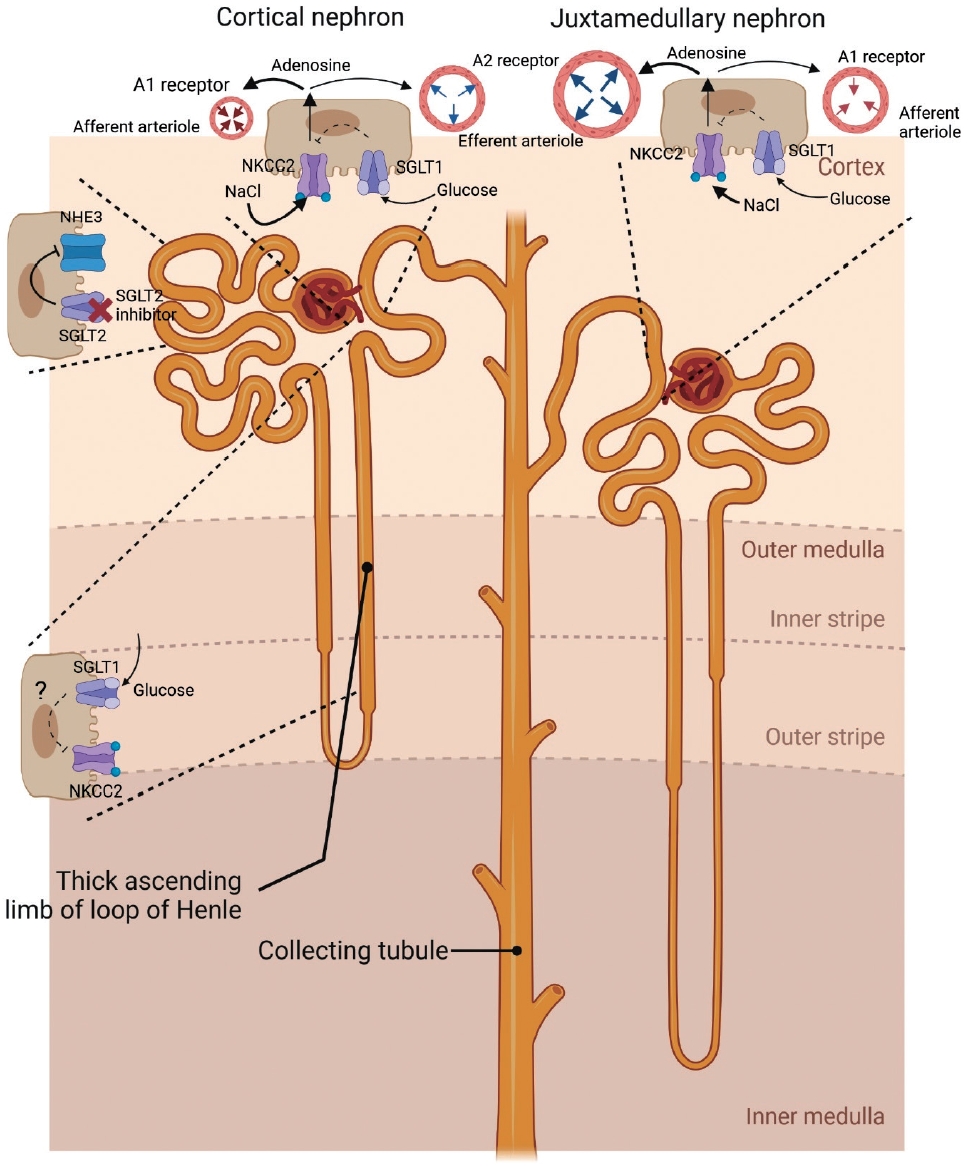Search
- Page Path
- HOME > Search
- Diabetes, obesity and metabolism
- Intrarenal Mechanisms of Sodium-Glucose Cotransporter-2 Inhibitors on Tubuloglomerular Feedback and Natriuresis
- Eun Sil Koh, Gheun-Ho Kim, Sungjin Chung
- Endocrinol Metab. 2023;38(4):359-372. Published online July 24, 2023
- DOI: https://doi.org/10.3803/EnM.2023.1764

- 2,675 View
- 437 Download
- 4 Crossref
-
 Abstract
Abstract
 PDF
PDF PubReader
PubReader  ePub
ePub - When sodium-glucose cotransporter-2 (SGLT2) inhibitors were first introduced a decade ago, no one expected them to have substantial effects beyond their known glucose-lowering effects, until the emergence of evidence of their robust renal and cardiovascular benefits showing that they could attenuate progression of kidney disease, irrespective of diabetes, as well as prevent the development of acute kidney injury. Still, the precise and elaborate mechanisms underlying the major organ protection of SGLT2 inhibitors remain unclear. SGLT2 inhibitors inhibit the reabsorption of sodium and glucose in the proximal tubule of the kidney and then recovers tubuloglomerular feedback, whereby SGLT2 inhibitors reduce glomerular hyperfiltration. This simple demonstration of their beneficial effects has perplexed experts in seeking more plausible and as yet undisclosed explanations for the whole effects of SGLT2 inhibitors, including metabolism reprogramming and the modulation of hypoxia, inflammation, and oxidative stress. Given that the renal benefits of SGLT2 inhibitors in patients with kidney disease but without diabetes were comparable to those seen in patients with diabetes, it may be reasonable to keep the emphasis on their hemodynamic actions. In this context, the aim of the present review is to provide a comprehensive overview of renal hemodynamics in individuals with diabetes who are treated with SGLT2 inhibitors, with a focus on natriuresis associated with the regulation of tubuloglomerular feedback and potential aquaresis. Throughout the discussion of alterations in renal sodium and water transports, particular attention will be given to the potential enhancement of adenosine and its receptors following SGLT2 inhibition.
-
Citations
Citations to this article as recorded by- Results from a cross-specialty consensus on optimal management of patients with chronic kidney disease (CKD): from screening to complications
Mustafa Arici, Samir Helmy Assaad-Khalil, Marcello Casaccia Bertoluci, Jason Choo, Yau-Jiunn Lee, Magdalena Madero, Guillermo Javier Rosa Diez, Vicente Sánchez Polo, Sungjin Chung, Teerawat Thanachayanont, Carol Pollock
BMJ Open.2024; 14(3): e080891. CrossRef - Chronic Kidney Disease and SGLT2 Inhibitors
Eun Sil Koh, Sungjin Chung
The Journal of Korean Diabetes.2024; 25(1): 16. CrossRef - Genitourinary Tract Infections in Patients Taking SGLT2 Inhibitors
Veraprapas Kittipibul, Zachary L. Cox, Supavit Chesdachai, Mona Fiuzat, JoAnn Lindenfeld, Robert J. Mentz
Journal of the American College of Cardiology.2024; 83(16): 1568. CrossRef - Synopsis of the Korean Society of Nephrology 2023 Practical Recommendations for the Management of Diabetic Kidney Disease
Sungjin Chung
The Korean Journal of Medicine.2023; 98(6): 270. CrossRef
- Results from a cross-specialty consensus on optimal management of patients with chronic kidney disease (CKD): from screening to complications

- Clinical Study
- Characteristics of Body Composition and Muscle Strength of North Korean Refugees during South Korean Stay
- Sun Wook Cho, So Hee Lee, Eun Sil Koh, Si Eun Kim, Seok Joong Kim
- Endocrinol Metab. 2015;30(4):551-556. Published online December 31, 2015
- DOI: https://doi.org/10.3803/EnM.2015.30.4.551
- 3,620 View
- 39 Download
- 3 Web of Science
- 4 Crossref
-
 Abstract
Abstract
 PDF
PDF PubReader
PubReader Background The aim of this study was to investigate the changes of body composition and muscle strength of North Korean refugees (NKRs) according to their duration of stay in South Korea.
Methods NKRs who volunteered and were living in South Korea, aged 20 to 75 years were recruited. Body compositions were analyzed by bioelectrical impedance analysis. Muscle strength was measured with the hand grip test. Demographic and migration information was obtained with a questionnaire.
Results A total of 158 volunteers were recruited at a mean age of 48.3±11.4 years. The mean time from when they escaped from North Korea and arrived in South Korea was 5.8±4.3 years. Height, weight, and body surface area were significantly smaller in all NKRs compared to South Korean controls, except for women aged over 50 years. In females of younger ages (<50 years), NKRs with more than a 4-year stay in South Korea had a higher weight and fat mass than that of those who had a shorter stay (less than 4 years) in South Korea. All NKRs had a weaker grip strength than that of the age-matched controls from South Korea.
Conclusion The NKRs showed relatively smaller physiques and weaker muscle strength than that of the South Korean controls. In younger female NKRs, shorter South Korean stay group showed small body weight and fat mass than that of longer South Korean stay group. Specific health support programs might be needed.
-
Citations
Citations to this article as recorded by- Assessment of diet quality of adults from North Korea: using nutrition quotient (NQ) for Korean adults
SaeByeol Kwon, Kyoung-Nam Kim, Moon-Kyung Shin
Journal of Nutrition and Health.2023; 56(2): 217. CrossRef - Associations between grip strength, cardiorespiratory fitness, cardiovascular risk and mental health in forcibly displaced people from a Greek refugee camp
Markus Gerber, Konstantinia Filippou, Florian Knappe, Ioannis D. Morres, Emmanouil Tzormpatzakis, Elsa Havas, Harald Seelig, Flora Colledge, Sebastian Ludyga, Marianne Meier, Yannis Theodorakis, Roland von Känel, Uwe Pühse, Antonis Hatzigeorgiadis
Scientific Reports.2023;[Epub] CrossRef - Weight Gain Predicts Metabolic Syndrome among North Korean Refugees in South Korea
Yoon Jung Kim, Yo Han Lee, Yun Jeong Lee, Kyeong Jin Kim, Sin Gon Kim
International Journal of Environmental Research and Public Health.2021; 18(16): 8479. CrossRef - Prevalence of General and Central Obesity and Associated Factors among North Korean Refugees in South Korea by Duration after Defection from North Korea: A Cross-Sectional Study
Yoon Kim, Sin Kim, Yo Lee
International Journal of Environmental Research and Public Health.2018; 15(4): 811. CrossRef
- Assessment of diet quality of adults from North Korea: using nutrition quotient (NQ) for Korean adults


 KES
KES

 First
First Prev
Prev



